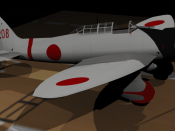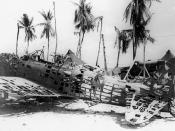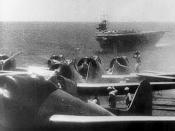The D3A Aichi Val, which entered service in 1940 and was designed to replace the D1A, was a Japanese dive bomber used mainly in the Pacific war during World War II. During the attack at Pearl Harbor, D3A led the first wave of attacks and was the first aircraft to drop bombs on American targets. The Aichi Val, weighing 5,309lbs on an empty load, and 8,047lbs fully loaded, has in my opinion pitiful engine performance and firepower. But on the insanely plus side, the D3A "Val" has amazing maneuverability performance. At very low speeds, it can turn almost like a kite!
In 1936, the Imperial Japanese Navy Air Force decided to update its carrier borne (Something that can take off from a carrier.) air resources, which were mainly the biplane (Planes with two pairs of wings.) type with fixed landing gear (Wheels won't draw back.). Therefore, during the summer of 1936, the Japanese Navy issued a requirement for a carrier borne monoplane (Planes with only one pair of wings.)
dive bomber to replace the D1A biplane dive bombers. The three companies who replied to the requirement were Aichi, Mitsubishi, and Nakajima, and the first two that replied received a contract for the two prototypes. The main manufacturer ended up being Aichi Tokei Denki K.K., later renamed Aichi Kokuki K.K. The D3A was the first all metal, low wing monoplane dive-bomber to serve with the Imperial Japanese Navy. A total of 478 D3A's were built.
The Val's engine power plant was one Mitsubishi Kinsei 54 radial piston engine, rated at 1,300hp (969KW) for take-off and 1,200hp (895KW) at 9,845ft (3,000m). The top speed of the Val, 267mph on a bomb-less ride, was very low compared to other British bombers, whose top speeds were around 350mph. Primarily because of the Val's speed,


